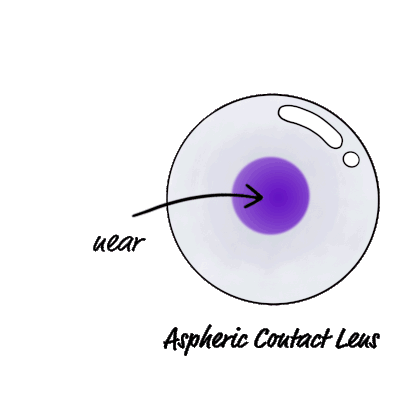Magic of Multifocals
6 min Oct. 22, 2021
Getting older is great. With age comes wisdom and the prospect of retirement. What’s not to love?
One answer is failing eyesight. As we grow older, many of us need help with our vision. The good news though is that, through multifocal lenses, crystal-clear sight remains accessible for everyone, however old we get.
LOSING FOCUS WITH AGE
From the moment we’re born, the lenses inside our eyes start losing elasticity. Once we hit 40 or 50, this loss tends to become more noticeable. Since the lens operates as our eye’s autofocus system, allowing us to see near and distant objects equally sharply, this creates an issue. Instead of clear sight, we find it harder to focus on objects close to us, without moving them further away. That’s why the condition is often called ‘too short’ or ‘long arm’ syndrome.
But why use a fun name when you can give it a Latin one?! The scientific name for this wholly normal condition is Presbyopia. You’ll usually know you’re developing it when things slowly become less clear close up, like a blurry book page, a hard-to-read message on your mobile phone or a difficult-to-discern font on your tablet or laptop. Basically, anything within arm’s length becomes a challenge.
You may also notice that when you shift your gaze between different distances, it talks longer to bring them into focus. Presbyopia is separate from - and additional to - other eye conditions like short sightedness (myopia) and astigmatism. If you’re long-sighted (a hyperope), you may notice the onset of Presbyopia at a relatively early age, perhaps in your mid to late 30s. As soon as this blurring and confusion starts to become an issue, visit your optometrist to get your distance vision corrected.
REGAINING FOCUS, THROUGH MULTIFOCALS
Multifocal spectacles - also known as varifocals and progressives - have been around for years. The most established form is the simple pair of reading glasses. These correct for near vision, but if you look through them into the distance, all you see is a blur. Anyone who uses reading glasses soon gets used to pushing them down their nose - peering over the top to talk to someone, watch TV or focus on a computer screen. Hence the name ‘half-readers’.
The next step up is a pair of bifocals. As the name implies (bi meaning two), traditional bifocal lenses incorporate two different prescriptions. The top half covers distance vision and the bottom ‘window’ is for near distance vision, such as reading.
So with bifocals, there is no need to push these frames down to look at objects further away. You just look up, through the top half of the lens. Your grandparents probably wore (or still wear) this kind of multifocal glasses. You may have an image of them in your mind’s eye, tipping the frame or their head to ensure they’re looking through the right part of the lens.
Bifocals spectacles do a great job, so why would anyone want a better solution?

Well, they may work well at first, but as your eyes continue to lose elasticity, more power is needed in the bottom window for reading - and as the contrast in your prescription grows, intermediate images become increasingly blurry. It’s time for multifocals, letting you see clearly and seamlessly at all distances, from near to far.
PUT THEM IN AND FORGET THEM
Of course, you could select multifocal glasses, but there’s an alternative and arguably better option. The wonderful thing about a multifocal contact lens is that it does everything multifocal glasses can do, without having to move your head or be aware of the transition from one viewing distance to another. No one will ever guess you’re presbyopic: you simply wear these modern wonders of science and let them do all the adjusting work for you.
They do this through ‘concentric’ alternating rings of different powers, or an ‘aspheric’ design, which increases or decreases the power gradually from the centre outwards. Most designs follow the latter approach, correcting for near distances at the centre, then covering intermediate distances before using the outer section to deal with objects further away (correcting the underlying Myopia or Hyperopia). If you already have good distance vision, the outer section won’t have any correction function at all.
Each design sees the multifocal contact lenses focus light from all distances onto the retina, so as a contact lens wearer you get to see close up text, computer screens and the horizon with equal ease and clarity. Just adjust your gaze to enjoy crystal-clear vision in all dimensions and directions. You’re back to a time when everything about your eyes simply ...worked.

WHERE TO WEAR?
You can wear your multifocal (or bifocal) contacts for a particular occasion, like going to the gym, playing golf or having a night out. In such cases, it makes sense to use daily disposables. They can be worn all day at work, at home watching TV, or when you are out and about, enjoying your social life.
Either way, your multifocal (or bifocal) lenses remain quietly efficient and effective - from the moment you pop them in, in the morning, to the moment you take them out before bed. Wonderful!
GETTING USED TO NEW SIGHTS
As with multifocal eyeglasses, it may take a while to adapt. Getting used to multifocal contact lenses might take you just an hour or so, or a day or two. For a few people, adjusting takes a little longer, for some no time at all. Yet once your eyes and brain have adapted to the new way of seeing, multifocal magic becomes a daily joy.
Instead of juggling spectacles and their cases, you can see a menu as clearly as a shop sign and your phone as crisply as a distant animal. Instead of hanging glasses round your neck or perching them on your head, you’re free to forget you ever needed vision correction, even when driving.
You may keep a set of glasses for evenings or as a back-up. You may prefer to swap your lenses for reading spectacles when in bed, wanting to complete your night preparations and take out your lenses before drifting off to sleep. If you do specialised close-up tasks like model-building, you may wear glasses over your contact lenses. But apart from these rare moments, your liberation is complete.

AS GOOD AS GLASSES (BUT MORE CONVENIENT)
Modern eye health and contact lens technology have moved on in leaps and bounds, ensuring that almost anything spectacle lenses can correct, soft or rigid varifocal contact lenses can do - less visibly and more conveniently. That creates a wonderful choice: select physical frames, or go for tiny plastic lenses, applied directly onto your eye surface.
Either way, the world comes into remarkable focus - giving you a new lease of life.
ALWAYS READ THE LABEL AND FOLLOW THE DIRECTIONS FOR USE.
All content on this website is for informational purposes only, always talk to your health professional regarding your eye health or medical conditions.
Never disregard the advice of a medical professional.
